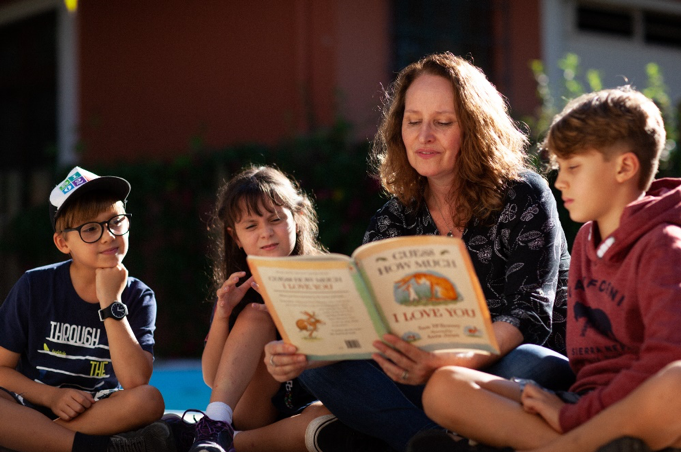One of the most powerful language experiences for a young child is to listen to a story. It can be a picture book, a personal story, an anecdote, a family joke, a whimsical poem, a song or an old fable. Whatever the style, we must remember that stories are like a journey to the child that opens up the world and reveal secrets, hidden under magical stones.

Children may start reading quite naturally and according to their own personal needs and curiosity, but sometimes we underestimate how difficult it can be for some of them to grasp the words, the sounds, and their meaning, especially in a second language.
Telling stories is within all of us, so practicing the skills to tell a good story in your classroom, can be key in setting the stage for your students’ language and literacy skills. For teachers of another language, it will be important to think of ways to transfer meaning and build connections between the words, the images, and the story message. The simple act of listening is a fundamental skill that is the first building block for speaking, reading, and writing.
Stories are all around us
Stories are all around us and can come in many forms. They can be from a book, they can be a song, a rhyme, a photograph, a recording, a letter, an interview, etc.
I’ve been using storytelling in my classroom for many years now, so I’d like to share some of the things that have worked well for me and my students.
Let’s start by looking at the ways we can tell a story in our classroom.
How can we use stories in our classroom?
- By reading from a book and showing the class the illustrations.
- By memorizing, the story and making it jump off the page by using gestures, our body language, puppets, objects etc…
Story Reading

Having the book in your hand and reading straight from its pages is perhaps the most common form, and for novice teachers, perhaps the best initial way to practice the art of storytelling.
Here are some of the positives:
- You don’t have to learn the story off by heart.
- You won’t have to worry about making mistakes with the language.
- The pictures in the books will help with understanding.
- Reading shows that books are a source of interesting ideas.
- Watching someone read from a book also encourages reading.
- You can follow the words with your finger as you read.
- Repeating the same story a number of times can help students develop language skills and improve their reading comprehension.
6 Tips on reading aloud from a book
- Let the students choose the story or at least give them a choice of three.
- Show students that we should handle books with awe and wonder, and that they are special treasures.
- Talk about the cover, the title, and ask students questions about it before you read.
- Hold up the book so that everyone can see the illustrations and give children time to see the little details.
- Use your voice to set the scene, give characters a different voice and use a variety of volumes and paces.
- When you finish telling the story, close the book slowly with care and reverence so that the magic continues.
Storytelling

While this mode of storytelling is more challenging for the majority of teachers, it can be so rewarding in the end. You don’t have to have any drama or artistic skills, you just have to practice!
Here are some of the benefits:
- It can have a very powerful and positive effect because children these days are not used to the experience of hearing someone tell a story.
- They will feel that you are giving them something personal.
- You can modify the language according to the students’ age range.
- You can use your body, your movements, and gestures more kinesthetically.
- You can watch the children’s faces, and how they respond to the story while you are telling it.
6 Tips for a storytelling session
- Choose a story that connects and reverberates with you and your students.
- Decide on what extra props you might want to use, ex: a special storytelling hat, a puppet, sound effects, specific objects that come up in the story, etc.
- Practice the story a number of times and use a mirror to watch yourself.
- Get the students to sit close to you, in a semi-circle, on the floor if possible, and use a story warm-up to get them focused.
- Organize the story sequence in your mind but leave some space for improvisation if something happens.
- Give time for students to react to the narrative, laugh, clap their hands, etc.
Whichever way you choose to tell your classroom story, remember that your joy and enthusiasm for what you are doing will encourage your students to connect to you and the story message. You will only get better at storytelling by practicing and try things out! Good luck!
Did you see Lucy’s recent webinar ‘The Magic of Reading: Using Stories to Promote Literacy and Learning’? If you missed it, you can watch the recording here.
Look out for the next blog posts on the following topics:
- Connecting to your students through stories: How to tell a personal story using memorabilia and ways to involve your whole audience.
- Setting the Story Stage: How to prepare your classroom for a wonderful storytelling session, and how storytelling warm-ups can help children concentrate and listen.
- Creating a magical atmosphere for your classroom stories: How to use cloth to make simple story puppets come alive!


